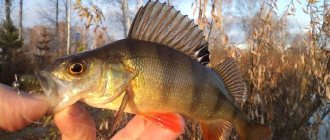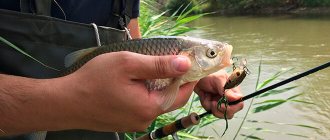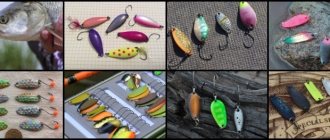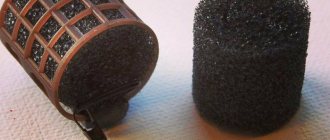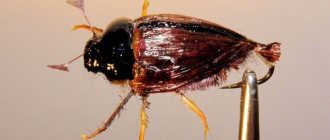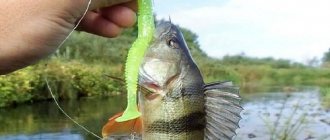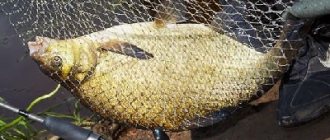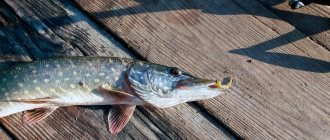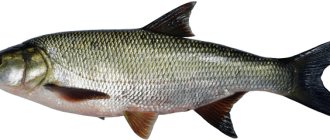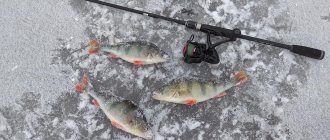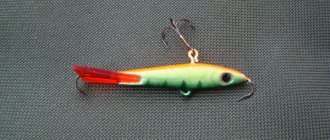A chub caught on a spinning rod is the pride and joy of any angler, especially a less experienced one. It’s not so easy to find and persuade a handsome red-feathered bird to strike. For successful fishing, you need to know the habits of the big-headed daredevil, its camping and hunting places, and have in your arsenal suitable tackle and bait aimed at catching chub.
Successful, targeted chub fishing is a step up in skill; a spinning angler, once he has mastered it, will never give up hunting for a worthy opponent.
Moreover, from season to season, from river to river, from region to region, all factors are changeable and you need to be able to quickly navigate an unfamiliar body of water in unfamiliar situations. And this is possible if you know how to analyze a body of water, weather conditions and other factors.
Some may say that in the spring, for example, chub can be more successfully caught using hooks, a feeder, or a fishing rod. There is some truth in this, but, alas, there is no such danimi and beauty as on a spinning rod.
So, what do you need to successfully catch chub with a spinning rod? There are four components of success:
- You need to have verified suitable gear.
- You need to choose the right bait for fishing.
- You need to know exactly where the chub stands at one time or another on a particular river.
- How to properly present bait.
Stage one - select and assemble a spinning rod for catching chub, prepare equipment
It is better for the goosefish to have two spinning rods on hand. One is an ultralight class with a dough in the region of 1-8, 2-12 grams and the second is a medium class with a dough in the region of 5-21, 8-30 grams. It all depends on the bait used, the intended predator and fishing conditions.
It should be remembered that the grip of the handsome big-headed fish is sharp and biting, plus you often have to catch it in the current. Therefore, the form is needed with a safety margin for the test. In addition, a powerful rod will allow you to remove a lively and strong chub from rocky rifts, grass, and boulders.
A spinning rod for catching chub should be of fast action, but with a fairly sensitive tip.
In order to increase the casting distance of light baits on relatively heavy gear, you should use slippery braided cords with a thin diameter of 0.1-0.12 in absolute terms. For strong places, you may need a more powerful braid - you need to proceed from the specific conditions.
If desired, you can use monofil or fluor. Diameter is around 0.18-0.23.
The length of the rod is from 2 meters. Longer for the shore, shorter for the boat.
The spinning rod equipment for chub should also include a high-quality reel 1500-2500 according to the Shimano classification. In this case, the cord must fit tightly onto the spool without overlapping turns; a finely tuned clutch is required. You need a high-quality fluorocarbon leash and the most delicate fittings (fastener, swivel 000 when fishing with spinners), connecting all the units of the tackle.
Universal tackle in our understanding, based on practical experience: the optimal spinning rod test for chub is 3-15 grams, rod length is 2.1-2.2 meters (this form is suitable for both a boat and the shore), fast action, a compromise cord of 0.1-0.12 diameter. The spinning rod should not “fail” when biting and playing, but at the same time be quite catchy. A specific rod can only be found experimentally to suit certain conditions.
The bullhead's equipment includes:
- wading boots or a suit for fishing on the rifts;
- trout landing net for careful catching of fish;
- kukan;
- polarized glasses will allow you to more clearly understand what exactly is happening at the surface of the water - to distinguish obstacles under water, to observe the play of bait in the distance, and sometimes even the fish biting;
- a shoulder bag or a special fishing vest with many pockets for baits and related equipment;
- A lipgrip (special grip) is used for the same purpose as a landing net.
Choosing a spinning rod for chub fishing
Since the habitats of the chub are difficult to access, and extreme caution must be exercised when searching for them, it is best to use ultralight spinning rods to catch them. The spinning test is selected according to the type of bait used and, depending on the manufacturer, can vary from 1 to 10 grams. The most acceptable choice here is to choose gear with a test weight of 7 to 10 grams, since when catching chub light baits are used and a larger test is simply not required. Another plus is that the ultralight allows you to make an accurate cast, which is very important if fishing is carried out in snags or other hard-to-reach places.
The accuracy and casting distance are also affected by the length of the rod; it can reach up to 4 meters if fishing is planned in large standing reservoirs, from dams or dams. This configuration allows you to cast just above the location of the chub and perform a retrieve without scaring the fish. A universal size, which is suitable for fishing both in the current and in backwaters, is a spinning rod length from 2.1 to 2.5 meters.
We recommend reading: The most effective and reliable floats for fishing in currents
The action of the rod should be medium; fast and super-fast are not suitable. Such rigidity has all the necessary qualities - to cast long distances with a small mass of bait, and also to easily land fish if its mass is large. For these parameters, there are three rod models recommended for chub fishing:
- Graphiteleader GNFPTS-762UL-LT. Professional spinning rod with a length of 2.29 meters, Regular Fast action and excellent test for catching chub from 0.6 to 10 grams, made of innovative graphite-based material with the Super Quattro Graphite Cloth trademark. It has a durable plug design consisting of two sections. Equipped with Fuji guide rings and an ergonomic EVA handle.
- Aiko Dixi 195 UL. Lightweight two-section plug-in fishing rod weighing 88 grams, ultralight style from the budget line. It has excellent characteristics for its segment, Regular Fast action, length 1.95 meters with a handle size of 27.5 cm, made of EVA material. The rod test ranges from 1 to 7 grams. It is equipped with Alconite fittings and is perfect for beginners for chub fishing.
- Airock line from Major Craft. A whole series of ultralight rods that go beyond the budget range. Options with different tests are presented, among which the angler will find what he needs for fishing in the chosen body of water.
Of course, only a small part of the possible spinning rods for chub fishing are presented here and are suitable for those who are just starting out, since usually an experienced angler chooses the tackle himself, based on his knowledge and preferences.
Stage two - forming a universal set of baits
The following baits are mainly used for catching chub:
- wobblers (crankbaits, shads, minnows);
- rattlins;
- microoscillators;
- spinners;
- silicone baits.
Wobblers always work if you make the right choice
Most often, when catching chub, they use small cranks (here it is very detailed and relevant), shads, and minnows. The most universal size is 4-7 cm, weight 3-8 grams. Sinking, suspending and floating models are used.
Sinking ones have the advantage of being more striking, this is an important factor. Plus, sinking wobblers with a depth of 1-2 meters can be driven to the bottom, which sometimes gives the best result. Option for use: riffles with a depth of one meter, pits near the shore, points near snags and boulder rubble.
At the same time, floating models can be fed to chub using the rafting method. They are also more relevant on shallow rifts of 0.5-1 meters, where the chub rises to the very surface in search of prey. Therefore, it is worth proceeding from the fishing conditions and behavior of the predator.
Popular catching and universal models of wobblers for chub include:
- Yo-Zuri 3DS Flat Crank. 5.5 cm, 7.5 grams. An interesting bait with an original shovel shape. Good for shallow riffles, depth in practice is up to half a meter.
A very good crank for chub - an underground nickname among spinners on the “Sedoy” forums - Yo-Zuri L-Minnow 33 and 44 mm - catchable and, apparently, the most famous “minoshka”. In these sizes it is very good for chub. Very long-range, they don’t lose their grip even in fast currents, which is very important when catching chub.
- Salmo Hornet F (floating) and S (sinking) 25, 35 and 40 mm. Ultralight babies are good in the spring. The most popular sinking one - it flies further, holds the stream better and catches where the chub often stands. Uniform wiring with teal on the bottom for raising turbidity. The lightest tackle is required - thin flurry, micro fasteners 000.
- Smith Camion SR and DR 2.5 grams. Classic. Very working fat cranks on a uniform wiring. It works upstream, across and against the current, without losing the game. A very important indicator for chub.
- Smith Camion Magnum, 3.6 grams. A heavier version of Kamion. Favorite for chub and asp on the rifts. Slow lazy wiring.
- Pontoon 21 Cheerful from 34 to 60 mm models, weight 1.6-7.2 grams. Accordingly, the tackle must be selected according to the specific bait for the casting distance and controlled retrieve. Very high quality workmanship and paintwork. There are interesting colors. Wiring - uniform, twitch, for demolition with stops and twitches.
- Jackall Chubby the entire model range. A classic for chub, there are models for almost any fishing conditions. It is stable in the current, does not fall over, does not fail. Suitable for both calm water and current.
- Usami Kabu 2.5 cm, 2.5 grams - ultralight inexpensive wobbler, flies tolerably, works well for demolition. They write on the forums that they come across defective copies - the ball for long-distance casting gets stuck. We didn't come across any.
- Strike Pro Baby Pro, 3.5 cm, 3.5 grams. Another budget baby. It holds the jet well, but doesn't fly very well. For drift and wade fishing. The wiring is uniform, you can vary it with pauses.
- Jackall Chubby Minnow, 3.5 cm, 2.3 grams. Chabik in minnow form factor. It doesn’t hold the stream as well as the Chubbik, but across the current, when moving for drift and in a slow stream, it doesn’t lose its play and catches well chub, ide, and white fish. Light twitch, regular with pauses.
- CrackJack 38, 48, 58 in various variations of depth and buoyancy depending on the season and fishing conditions. Flying bullets work on uniform, stop and go, light twitch. They are used for demolition and upstream; burrowing versions are good for fishing underwater obstacles.
- Rapala Mini Fat Rap, 3 cm, 4 grams. Ultralight wobbler from Rapala. Quite a low-frequency game, on the riffles it seduces chub and ide. It holds the stream well, does not fall on its side and does not get lost in chaotic movements.
- ZipBaits Rigge 35F, 3.5 cm, 2 grams. A small “booger”, flight qualities are so-so, otherwise it’s a great bait for chub, ide, and white fish. It works only on the most delicate tackle, preferably without a leash or on a thin fluke, so we do not recommend fishing in “strong” places. Wiring for demolition, against the flow at the slowest pace with pauses and stops. Ridge 35 can surprise you if you approach it. We hardly recommend it for beginners. It is expensive and requires the finest gear, which can lead to the loss of bait.
- Tsuribito Baby Crank 35S-SR, 35F-SR, 3.4 and 3.1 grams, respectively. A high-frequency device with a good casting range, a floating model works well in shallow riffles and when fishing over grass that extends almost to the surface.
For fishing along overgrown and very shallow riffles, you can and should use wobblers with zero depth and other surface baits.
Wobblers with zero depth, working for chub:
- Owner C'ultiva Bug Eye Bait 48 mm, shallow chub crank crank, digs a depth of no more than 20-30 cm with the stated 50 cm. It has a very high-frequency game, vibrates strongly on the slowest retrieve.
- OSP Buzzn' Crank 5 cm, 10 grams - a catchy heavy crank, with almost zero depth, for large and medium-sized chub.
- Megabass Baby Griffon Zero Trout 3.8 cm, 5.3 grams. Famous wobbler from Megabass. Good for regular fishing, practical for independent play without the participation of a spinning player.
- Yo-zuri Hardcore 0 6.5 cm, 8 grams - floating surface finish for overgrown riffles.
- Jackall Cherry Zero Footer 4.8 cm, 7.6 grams. Subsurface for large chub on riffles.
We recommend! To increase the fish catchability, you should replace all tees on baits with high-quality anchors from Ovner and Jamakatsu thin series. An additional bonus is that such tees bend when hooked at a break, but do not bend when hooking even the largest and most lively fish.
Turntables are good in certain conditions
Rotating spoons work better in relatively calm water and when fishing upstream - casting bait upstream relative to the angler's riser. On rifts, rapids and when fishing against the current, they are squeezed out, which is not always good, but only if the predator feeds in the upper layers and in a situation where the fishing place is shallow, up to a meter deep.
To catch chub, high-quality spoons of numbers 0-2 according to the Mepps classification are used. Mepps, Daiwa, Pontoon 21, Blue Fox. The Comet or Long petal, which allow fishing in strong currents, squeezes Aglia to the surface.
Rotating spoons with a heavy core work effectively - Smith Niakis, Myran, Mepps Heavy, Daiwa Silver Creek, Blue Fox Vibrax, etc.
You can also use Panther Martin spinners and other in-line spinners. They are very resistant to currents, do not stick and do not go astray even on the slowest retrieve. Numbers 1-2.
Daiwa Silver Creek
Pontoon 21 Ball Concept
We do not recommend using Chinese “pod(D)fir trees” - they do not hold the current, they get lost in the game, and are thrown onto the surface of the reservoir.
Micro-oscillators - classic oscillating spoons experiencing a rebirth
Micro-oscillators are experiencing something of a renaissance after temporary oblivion. In addition to the reputable Japanese companies - Nories, Smith, Water Land, Forest, Daiwa, domestic companies SV Fishing Lures, Kosadaka and others began to produce high-quality spinners.
Spinner baits have the advantage that, unlike wobblers and spinners, they can be thrown more accurately and far. Also, in some cases, only micro-oscillators allow you to catch chub, especially in spring and autumn.
There are a great many oscillating spinners. We recommend purchasing in several sizes, shapes and colors in order to try this type of bait. Our opinion is an indescribable aesthetic pleasure.
You can look for Japanese people on thematic forums and on foreign sites. There are enough offers.
It’s difficult to recommend anything specific, 5 micro-oscillators, the most successful not only for chub, but in principle:
- Nories Masukurouto Boon. A very compact spinner that works close to the bottom. Medium frequency fluctuations. It flies like a bullet. We recommend.
- Smith Pure. 2.7, 5, 6.5 grams and other models.
- Waterland Range, 2.5, 3 and 4 grams. Sizes 2.5 and 3 cm. A spinner that has a wonderful geometry and the same game. The game changes depending on the speed of the wire. It catches by permanently tempting chub and other fish to grab it. The price, however, is steep.
- Williams Wabler W30. 4 grams, size 3.8 cm. Expensive vibrators made of precious metals. They have a stiffening rib, which allows them to hold the stream efficiently even for such a small one. It works on a uniform basis, Wobbler loves it.
- Smith Flaky 4.5 g is a very long-range bait. Chaotic twitch, jerks, pauses and slowdowns.
Microsilicon for chub is not the number one choice, but sometimes it “shoots”
Silicone baits are purposefully used for catching chub quite rarely, but sometimes micro-silicon baits work very well along the bottom - worms, slugs, crayfish and other crabs, when moving along the bottom when a chub is standing there, can provoke the big one to grab. Fishing time is autumn, spring or cold nights, when the chub can roll to the bottom. Size 1.5-2.5 inches is the most popular
Rigs - standard jigging, eared, drop-shot, slip-shot, Carolina rigs.
The following manufacturers have quality baits
The chub is more likely to accept silicone baits if they resemble not a fish, but another food source for the redfin - crustaceans, snails, worms. For this reason, it is worth selecting silicones based on this postulate.
Fishing for chub with a spinning rod on a medium-sized river
Typical examples: Ugra in the middle lower part, Moksha, Tsna, tributaries of the Don, Don in the upper part, Nerl Volzhskaya and Nerl Klyazminskaya. If you catch high-riding schooling fish, which most often stand on a “clean” riffle, with small baits, then fairly light spinning rods with weights up to 7-8 g for bait and 5-8 lb for fishing line are quite suitable. Catching a large chub among 500-gram small fish is quite a rare occurrence. After all, a seasoned lobster always sticks to coastal shelters - snags, holes, coastal washouts or burrows of various animals. In 8 years of intensive chub fishing on our trips, only once did a lone “connecting rod” weighing almost 2 kg come across a wobbler in the middle of the Don, and even then in the morning it turned out that in that place on the river bottom there was a flooded snag. I caught a slightly smaller chub, weighing 1750 g, on the Alym River, and also from the middle of the river. And again in the middle of the river there was shelter - a large snag, under which the fish stood.
All other large chubs (conditionally fish weighing more than 1.5 kg can be classified in this category), including 3.4 kg caught in 2007 by Nikolai from Efremov, were caught along the coastline, in well-studied places of typical chub camps. The fisherman, knowing in advance several points on a certain section of the river, tries to lure the chub out of its ambush. This kind of fishing is very difficult, it requires a lot of patience and skill. Not only do you need to correctly place the bait in the parking area, you also need to correctly place it in the desired horizon, periodically changing the models and colors of wobblers, taking long pauses in fishing, so as not to alert the fish with overly active actions. On one of the Don tributaries, I once spent almost half a day on one snagged coastal hole, changing baits and taking breaks. But then, when the fish’s nerves couldn’t stand it, I took three beautiful chubs in a row. One of them weighed 1.6 kg. And they only managed to hold on to two more, and even then not for long: Fireline 0.15 couldn’t stand it. It is not possible to use a stronger and thicker cord: the pressure of a strong current changes the play of the wobbler and the manner in which the bait is presented. In passing, I note that it is flat cords that work better in strong currents.
In such conditions, the power resource of the spinning rod and its competent operation during... no, not fishing, but, for starters, “holding” the fish in one place for a long time are of great importance. How long this “hold” will last until the fish gets at least a little tired and it is possible to start fishing depends on its strength, the speed of the current in this place and the skill of the fisherman. When fishing with a spinning rod that is too hard, the fish will certainly come off; if you choose one that is too weak, with a soft butt, the fish will come off even faster. But this is where the main nuances with the sensitivity of the spinning rod begin. Thus, a very light spinning rod perfectly works with the wobbler, and fishing with it is very comfortable. The angler feels any touch of branches under water, which is important when it is necessary to detect the outer branches of a flooded tree in order to “outline” the obstacle and determine the boundaries beyond which the bait cannot be taken. The spinning rod is too powerful and does not have the required sensitivity, resulting in dead hooks and broken baits. Not only are expensive wobblers lost, but also the extra noise, the swaying of branches when the cord breaks, scares away the fish standing nearby. In this case, the chubs become wary and move deep under the shore.
Models of spinning rods for medium rivers can be called the following. Norstream Dynamic-2 Twitch special 76 L, 3-15 g. This spinning rod, designed specifically for jerk fishing, is ideal for catching large chub in snags. “Silver Stream Typhoon” 2.40 m, test 2-14 g. This is exactly the model with which several chub weighing more than 2 kg were caught. For example, the aforementioned Nikolai from Efremov, as well as many of my acquaintances, fish with this spinning rod. CD-Rods Extrasense 7.9, 5-19 g and CD-Rods Blue Rapid 7.6, 3-14 g. These models have also been extensively tested on chubs and have proven their worth. Errors in choosing a spinning rod for fishing near chub camps are obvious, and many cases can be cited when, because of them, the fish left the angler not only without bait, but also without the cord, taking it all away. Here is a typical example.
One late evening, my travel partner, wearing waders in chest-deep water, moved along the shore, making casts. He returned very upset and excited. It turned out that on the next trip his wobbler was grabbed by a big fish. The cord began to rapidly leave the reel, but attempts to tighten the clutch led to nothing. A light spinning rod with a dough of up to 7 g instantly bent to the handle and stopped working. It was not possible to push the fish away from the shore. When the cord ran out, the fish easily broke it off and left. The spool remained completely empty. It’s a pity, by the way, not so much for the cord as for the fish.
Very often on medium rivers you have to fish from the bank, breaking through to the water through thickets of nettles and hops. Casts in such places should be point and very short, along trunks and branches. This kind of fishing is a bit like “flipping”, the only difference being that you have to stand on a steep clay bank, having difficulty maintaining your balance. Fishing is also very short and forceful; the fisherman’s task is to prevent the chub from getting the line behind the snag. Surprisingly, in such conditions, some masters manage to catch and hatch trophy fish. For example, the famous spinning player Igor CHELISCHEV managed to pull a fish weighing about 4 kg from a steep bank! To be honest, it’s hard to even imagine how in such conditions it’s possible to make an accurate cast, let alone pick up such a giant! Igor Chelishchev uses a handmade rod: the blank on a homemade mandrel was made by E. SEREDA, and the assembly was carried out by Igor himself. The parameters of this spinning rod: length is about 8.3 feet, the test can be estimated as 3-18 g. What is typical, Chelishchev believes that such parameters of the spinning rod are the minimum power that should be used for any chub fishing if there is “concern” that there are large chubs in the river.
For such coastal fishing, in principle, many rods with a length of about 8 feet are suitable - it’s difficult to control the bait in such conditions - and the test for baits is up to 14-21 g. It’s not worth taking spinning rods for such fishing that are too slow, “noodles”, You should also use rods that are too hard. After all, the blank must not only have a restraining capacity, it must also dampen the movements of the fish. The models described above for catching trophy chub in many cases are also suitable for such spot fishing from cliffs. By the way, don’t think that this fishing is such a rare occurrence. In my recent trips to the southern rivers for chub, many points were fished exactly as described above. And the “harvest” captured in this way was many times greater than what was achieved by comfortable fishing by wading from the river, when the spinning angler could comfortably stand in a roll.
Stage three - where is the chub, where should a spinner look for it?
Most often, chub prefers small and medium-sized rivers.
It stays on the rifts and directly next to them - at the entrance/exit of the rapids. It also prefers places under overhanging crowns of trees, bushes near steep cliffs, in ambush among snags, fallen trees, near bridge piles, near stone dams and similar obstacles.
They may also stand in niches - potholes in the banks, at the edge of fast and slow water, in the so-called “watering cans” - places where bays and oxbows branch off from the river.
It is almost always preferable if such places are located in close proximity to a riffle/rapid.
Early spring
In early spring, in March-April, the water in the rivers rises and becomes very cloudy after the winter flood, small and medium-sized rivers often overflow their banks. At this time, it is quite difficult to catch chub and, as practice shows, fishing with a donkey - a feeder - will be more successful. They are caught using peas, worms, and bloodworms.
If, as they say, your hands are twisting, and you really want to catch chub with a spinning rod in the spring, then you should prefer deep places near the banks, channel dumps, places among snags, river turns with a sharp change in current from slow to rapid. At this time, the water is still cold, and the chub, like all carp, is a heat-loving fish, and therefore is still quite passive and stands at the bottom. Lures include small passive and active silicone, less often wobblers, crankbaits and spinners.
Fishing for chub in the spring in May using a spinning rod:
Late spring and summer time
The best results come from catching chub with a spinning rod in late spring - summer, when the water has warmed up enough and the activity of the redfin has increased.
At the end of April-May, the water in the rivers gradually becomes lighter, and the rivers enter the banks. Insects and, first of all, May beetles begin to become active. At this time, the chub rises to the middle layers and to the surface of the water. Hunts under the overhanging crowns of trees and bushes, collecting fallen bugs and spiders. Also, with the warming of the water, they gradually come out to hunt in the rifts and surrounding areas. At this time, small crankbaits and shads, which are similar in appearance and behavior to insects, perform well.
As the water falls, the chub switches to faster riffles from slower ones.
Thus, it is worth understanding that the chub changes its stopping places during the season, and it cannot be said that the same point/riffle/rapid will work all summer. You need to look for Lobasty, live and live with him in the same rhythm.
Sometimes microoscillators, small turntables and microjigs also “shoot”.
Crank cockchafer - effective in late April-May
Throughout the summer, the chub stays near and on rifts, at the junctions of currents, in niches on the banks, among snags, and on arcs formed by sharp turns of the banks.
At this time, you can catch bigheaded fish by wading on the rifts, from the shore by casting across the current, by upstream with casting against the current, by rafting from a boat. By wading, catching chub can be doubly successful, due to the fact that the fish is not as wary of the fisherman in the water as on the shore.
On the river it is worth looking for places that are not typical for the general flow; any anomalies in the depths can serve as a parking lot and hunting ground for chub.
On small and medium-sized rivers, the peak bite is observed in June-July, on large rivers two weeks later.
Fishing for chub with a spinning rod is effective in the summer and early autumn of September, in the southern regions in October.
Autumn suffering
In the fall, chub is caught on a spinning rod in September-early October, while the water is still quite warm. Gradually rolls down to deeper areas and sinks to the bottom. But during the day, when the sun warms up, it still comes out to play mischief in the riffles. This leaves its mark on the fishing technique. In the morning and late afternoon, you should look for bigheaded fish in deep areas in the immediate vicinity of rapids using deep and medium-depth crankbait wobblers, minnows, and shads; microoscillators, turntables, passive silicone.
Winter wilderness
In winter, chub are certainly not caught from the ice using a spinning rod (what news), but they are still caught in open water - near dams and hydroelectric power stations. At such a time, you can try to catch it with the same baits as in late autumn in medium and deep water near the bottom.
Reviews from fishermen
Finally tested the long-awaited device (Rivolta 892MH). I bought it for jig, it is very convenient to work with running weights from 12 grams to 30, plus bait. No longer metal, I was very surprised by the sensitivity. As the Japanese write in TX, it is so. Very satisfied. Grade:
spic24
Spinning rod (GOTS-762L) + Vanquish 2500S reel, bought last year, delivered from Japan, it was not cheap. I fish with jigs, mainly zander and pike. The largest catfish we caught weighed 6 kg. Grade:
Michael
I purchased GLVS-622L. The impression is simply superb. I took this model specifically for twitching with small wobblers or throwing small spinners further away. Everything flies where it is intended. I think this invention can be considered one of the most successful among the light light class. Very good sensitivity and quite powerful. The price turned out to be too high for me, but the spinning rod is worth the money. Grade:
Alexei
I bought myself a VELOCE GLVS 642UL loaded with a Shimano reel as a gift. Well, what can I say, the balance is simply superb, it fits perfectly in the hand. I'm waiting for the season, I'll go test it. Grade:
Sanek
I have been using this model GVOS-702M for three years now. There is no equal for jig in its weight category. Chuika is excellent, flies perfectly. I tested wobblers only up to 10 cm, they pull well. At the beginning of October I bought a vivo prototype. So far the only difference I have noticed is that the prototype is more sensitive. The stick is super, I recommend it to everyone. Grade:
Sergey
Where can I buy?
This attribute can be purchased both in online stores and at specialized fishing points.
Stage four - how and where to properly present the bait to the chub
When catching chub on the rifts, it is worth considering that the bighead willingly attacks the bait at the entrance/exit of the rift. Entrances with blockages of stones, snags, and washed-up sand must be treated doubly carefully. The chub often hides behind such obstacles from the direct jet of a strong current. In such places you need to throw the bait several meters above the expected fish position.
On a note! Such places can be clearly identified by characteristic turbulence on the surface of the water, as well as through polarized glasses.
In general, wiring across a riffle works by blowing an arc from the cord at a minimum wiring speed, especially when it comes to actively vibrating potbellied cranks. It is also possible to cast against the current, with the rod tilted to the water at a maximum angle and at a minimum casting speed.
It is better to start fishing from points located downstream, so that when fishing you do not spook the fish that are higher than the angler.
On a note! Chub love places where a turbulent stream borders areas of relatively calm water - in the language of anglers, “mirrors”!
Lures for riffles should be such that they can be cast at a minimum speed - floating and suspending wobblers of the crank or shad class, less often minnows, light spoons, spinners.
Rule! The chub does not like fast retrieves, therefore the most effective animations are those in which the bait works to drift - this is perpendicular to the angler, as well as 30 degrees upstream and downstream. Depending on the speed of the current, the angle of attack may change. The sector is being worked out in a fan-like manner, gradually working out all the horizons of possible fish parking.
Weather
The hotter it is, the more turbulent the water the chub prefers, which is why you should look for it in the rapids itself, in the central zone of the rapids. When the temperature drops, the bighead moves closer to the edges, to mirrors, and even to areas outside the riffle, but in close proximity to it.
Catching chub with spoons on the rifts:
Secrets for successful chub fishing:
Catching chub by rafting from a boat using a spinning rod
Chub can be caught using a spinning rod or by swimming from a boat, more details here, and in this material we recommend watching a video about fishing for chub on a large river.
Catching chub using a spinning rod (swimming fishing):
Be merciful, let go of your defeated opponent and let him please you or your brother spinner with another bite.
Catching chub with a spinning rod on a big river
Conventionally, we include in this category rivers of such a scale in terms of water flow and width as the Upper Volga, Middle Don, Moscow River, Oka - that is, quite deep, deep and fast watercourses. Often chubs stand in such rivers at the very bottom, in holes, or on their border. Knowing such places, you need to position yourself wisely so as not to alert the fish with wrong actions. The best position for casting is a little higher from the hole, so that the bait moves with drift across the river, descending into the hole from a shallow area. Since the holes are often located far from the shore, you need a long-range spinning rod about three meters long, capable of casting not very heavy compact baits over a decent distance. In this case, these are rotating spoons - for example, Daiwa Silver Crick 9 g, Muran - or sinking wobblers. To complete the task, the actual top test of the spinning rod should be approximately 17-21 grams.
Now briefly about specific models of spinning rods for chub fishing. Lamiglas Esprit 96, 7-14 g, 10 lb line. There is a whole group of chub experts who fish on large rivers only with this model, considering it the standard for these conditions.
CD-Rods Blue Rapid 2.75 with 3-14 test or similar Sunrize parameters. According to the supplier of these products to Russia, both of these models are ideal for catching chub at long distances.
Herty Rize Seabass Force 902 UL with a test of 7-23 g. Due to the special geometry of the blank and the correct bending when casting, the model fully satisfies our tasks.
Norstream Ultrasense 90 L, 2-12 g, Norstream Stage 96 M, 7-30 g. Both models have undergone extensive testing on the Oka River. The second model seems overly powerful, but this is not so - “Stage” throws baits weighing 7-10 g perfectly.
Errors in choosing a spinning rod for such conditions will not allow you to solve the following important problems:
1. Make the required casting distance. 2. Control the bait while retrieving. For example, to deepen it sharply in accordance with the profile of the river or to avoid getting caught on the bank edge. 3. Confidently control large fish when fishing from a maximum distance in a strong current. The most serious mistakes should be considered the choice of a) a spinning rod that is too short, b) a spinning rod that is too fast and hard, c) a spinning rod with an overestimated test. But it should be said that on a large river, when fishing along its bank, especially wading, regardless of the casting direction (upstream or fishing with fishing against the current), it is possible, and in some cases necessary, to use shorter spinning rods. This is due to the fact that with a spinning rod that is too long it is very difficult to get fish into a short “back” racket landing net when you are standing in “wads” waist-deep in water in a strong current. On a large river, where there is freedom of maneuver and enough time to think, the spinning test may be less than when fishing in cramped conditions with a short rod.
Catching chubs with a spinning rod on small rivers
Perhaps these are the rivers that are most visited and loved by spinners who fish with wobblers. Here everything is simpler: although trophy fish are caught, they are still an order of magnitude less common than on deep rivers. The reason for this is banal: a small river is more easily dislodged by fishermen and poachers, it quickly suffocates and dies from the breakdown of any treatment facilities or the ingress of other nasty things. Therefore, when fishing, you can use lighter gear. For example, the Gary Loomis 842, 7 feet long, beloved by many anglers, in the IMX or GLX series. The safety margin of this spinning rod allows you to pull a chub 2 kg upstream. And in conclusion, I want to say that I in no way propose to consider the spinning rod models listed in this article as advertising and direct recommendations: fish with these spinning rods and you will be happy. Just from these models you can get a general idea of a good chub spinning rod. These are the models that I know better than others and which I have been able to test and experience many times. Knowing their characteristics, everyone can choose for themselves the model that best suits them.
